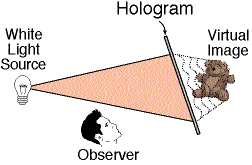First H1 to H2
-
Colin Kaminski
First H1 to H2
Danny is referring to the layers of high and low index parallel to the plate in a reflection hologram. More is better to a point. Each layer has diminishing returns.
-
Dutchelm05
First H1 to H2
Thanks Colin,Colin Kaminski wrote:Danny is referring to the layers of high and low index parallel to the plate in a reflection hologram. More is better to a point. Each layer has diminishing returns.
Still don't see it
Are these refering to the actual fringes that is created, i.e higher peaks and deeper valleys. So how are they parallel? Do they need to be clipped off like sinusoidal profile to a flat top?
-
JohnFP
First H1 to H2
Do some searching on Bragg Planes. 
Basically and simply, the standing wave pattern causes a hardening of the gel in DCG at the constructive interference sites. Due to the reflection geometry, those constructive sites run almost parallel to the surface of the emulsion (I can explain this more if you wish). So in essense you have layers of harden and unhardened layers. Is it the differneces of index of refraction of those layers that act as partial mirrors similar to seeing your reflection in a piece of glass. With a transmission hologram, the constructive interference sites run almost perpendicular to the emulsion surface. This is what photo etching in resist relys on. Those alternating fringes are standing up almost and thus the etching of just the exposed OR unexposed fringes causes ridges and valley on the surface. With a reflection this would not be possible.
But it is this reflection layering thingy that I like to play with. First, as I have stated, I now believe we develope and try to control the soft unexposed layers of gelatin, I used to think, just like silver, we were developing the exposed region. Second, thus the reason for the support lattice idea to color tune. We need to control the thickness of the unexposed layer and we can pretty much control color.
Basically and simply, the standing wave pattern causes a hardening of the gel in DCG at the constructive interference sites. Due to the reflection geometry, those constructive sites run almost parallel to the surface of the emulsion (I can explain this more if you wish). So in essense you have layers of harden and unhardened layers. Is it the differneces of index of refraction of those layers that act as partial mirrors similar to seeing your reflection in a piece of glass. With a transmission hologram, the constructive interference sites run almost perpendicular to the emulsion surface. This is what photo etching in resist relys on. Those alternating fringes are standing up almost and thus the etching of just the exposed OR unexposed fringes causes ridges and valley on the surface. With a reflection this would not be possible.
But it is this reflection layering thingy that I like to play with. First, as I have stated, I now believe we develope and try to control the soft unexposed layers of gelatin, I used to think, just like silver, we were developing the exposed region. Second, thus the reason for the support lattice idea to color tune. We need to control the thickness of the unexposed layer and we can pretty much control color.
-
JohnFP
First H1 to H2
I think you are thinking that the 1/2 wave destructive and contructive sites are next to each other. But really they are on top of one another. Side to side, in a true two collimated on axis reflection hologram you would get all the same as there is no differnce in wavelength distance traveled. Now take one of those off axis a little and there are alternating const and dest fringes created side by side but they may be an inch apart or whatever, depending on geometry.
-
Danny Bee
First H1 to H2
 I found this on the net to give you a mental picture.
I found this on the net to give you a mental picture.Now let’s make this really simple. The depth of the gel let’s say 10 microns have has 5 mirror fringes stacked on each other reflecting light back to the viewer. now let’s say we increase the depth to 20microns , we will also increase the amount of fringes stacks in the depth of the gel and that will doing a couple of things, one the more stacks the more narrow the band and the brighter replay of that bandwidth. like colins says "Each layer has diminishing returns" at a point in thickness
-
Dutchelm05
First H1 to H2
Thank guys,
Pictures and puppets are the best way to get a point across for me
I'm off to the lab this morning, see you on the other side
Pictures and puppets are the best way to get a point across for me
I'm off to the lab this morning, see you on the other side